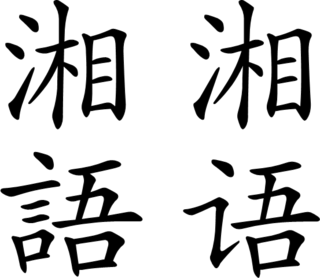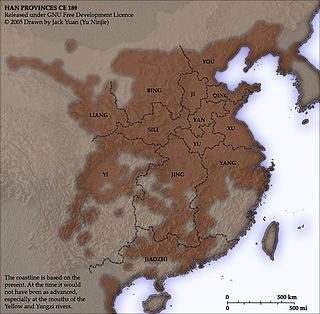
Shaoshan is a county-level city in Hunan Province, China. It is under the administration of the prefecture-level city of Xiangtan. Qingxi Town is its seat.

The Xiang River is the chief river of the Lake Dongting drainage system of the middle Yangtze, the largest river in Hunan Province, China. It is the 2nd largest tributary in terms of surface runoff, the 5th largest tributary by drainage area of the Yangtze tributaries. The river flows generally northeast through Guangxi and Hunan two provinces, its tributaries reach into Jiangxi and Guangdong.

Xiang or Hsiang, also known as Hunanese, is a group of linguistically similar and historically related varieties of Chinese, spoken mainly in Hunan province but also in northern Guangxi and parts of neighboring Guizhou and Hubei provinces. Scholars divided Xiang into five subgroups, Chang-Yi, Lou-Shao, Hengzhou, Chen-Xu and Yong-Quan. Among those, Lou-shao, also known as Old Xiang, still exhibits the three-way distinction of Middle Chinese obstruents, preserving the voiced stops, fricatives, and affricates. Xiang has also been heavily influenced by Mandarin, which adjoins three of the four sides of the Xiang speaking territory, and Gan in Jiangxi Province, from where a large population immigrated to Hunan during the Ming Dynasty.

Zhuzhou, formerly Jianning, is a prefecture-level city of Hunan Province, China, straddling the Xiang River southeast of the provincial capital, Changsha, and bordering Jiangxi province to the east. It is part of the "Changzhutan Golden Triangle". The city has jurisdiction over 5 counties and four districts, and covers an area of 11,420 km2 (4,410 sq mi).

Chu, often referred to as Ma Chu (马楚) or Southern Chu (南楚) to distinguish it from other historical states called Chu, was a kingdom in south China during the Five Dynasties and Ten Kingdoms period (907–960). It existed from 907 to 951.

Xiangxiang is a county-level city under the administration of Xiangtan, Hunan province, China. Located on Central Hunan and the west of Xiangtan, Xiangxiang is bordered by Ningxiang County and Shaoshan City to the north, Xiangtan County to the east, Shuangfeng County to the south, Louxing District of Loudi City to the west, it has an area of 1,912.7 km2 (738.5 sq mi) with a population of rough 850,000. It has 4 subdistricts, 15 towns and 3 townships under its jurisdiction, the government seat is Wangchunmen (望春门街道).
The Roman Catholic Diocese of Changde is a suffragan Latin diocese in the Ecclesiastical province of Changsha, in Central China, yet depends on the missionary Roman Congregation for the Evangelization of Peoples.

Xiangtan County is a county in Hunan Province, China; it is under the administration of Xiangtan City. Located on the east central Hunan, the county is bordered to the north by Yuhu, Yuetang Districts and Xiangtan City, to the west by Xiangxiang City and Shuangfeng County, to the south by Hengshan and Hengdong Counties, to the east by Zhuzhou County and Tianyuan District of Zhuzhou City. Xiangtan County covers 2,132.80 km2 (823.48 sq mi), as of 2015, it had a registered population of 979,600 and a resident population of 857,200. The county has 14 towns and 3 townships under its jurisdiction, the county seat is at Yisuhe Town (易俗河镇).

Jiangnanxidao was a southern province of Tang Empire. It corresponds to part of present-day Jiangxi, Hubei, Hunan, Anhui. Jiangnanxidao is the origin where the name "Jiangxi" derives from, and its administrative territories also roughly represent nowadays Gan-speaking areas in China.

Xiangtan is a prefecture-level city in Hunan province, China. The hometowns of several founding leaders of the Chinese Communist Party, including Mao Zedong, Liu Shaoqi, and Peng Dehuai, are in the Xiangtan prefecture, as well as the hometowns of Qing dynasty painter Qi Baishi, scholar-general Zeng Guofan, and tennis player Peng Shuai.

Changzhutan or Chang-Zhu-Tan, also Greater Changsha Metropolitan Region or Changsha-Zhuzhou-Xiangtan City Cluster ) is a city cluster in Hunan province, China, consisting of the provincial capital, Changsha and two other prefecture-level cities: Xiangtan and Zhuzhou; it is the main heavily urbanized region of Hunan and covers an area of 28,087 km2 (10,844 sq mi).

Changsha–Zhuzhou–Xiangtan intercity rail, is a high-speed regional railway in Hunan, China. It connects the provincial capital Changsha with Zhuzhou and Xiangtan. The line was opened to traffic on December 26, 2016. A northwestern extension to Changsha west railway station opened on December 26, 2017. The maximum operating speed is expected to be up to 200 km/h, travelling time between the three cities will be shortened to less than 30 minutes. The line uses China Railways CRH6F regional rail trains.
Changsha has a history going back over 3000 years. It has grown to an important town of economy, culture and garrison in the southern area of Chu State. In the Later Tang dynasty (923-936), the king of Chu, Ma Yin, founded the Chu Kingdom (927-963) and set it as the capital, the city quickly became the largest and most important population, commercial and financial center in southern China. It was devastated by the Second Sino-Japanese War and the Wenxi Fire in 1938 but was quickly rebuilt. As of 2016, Changsha was ranked 13th of ciities of China by comprehensive strength in 2016.
Ma Xiguang (馬希廣), courtesy name Depi (德丕), was the fourth ruler of the Chinese Five Dynasties and Ten Kingdoms Period state Chu.

Kaifusi station is a railway and subway station in Kaifu District, Changsha, Hunan, China, operated by CR Guangzhou and Changsha Metro. It opened its services on June 28, 2016. Kaifusi/ Temple Station offers interchange between Changsha-Zhuzhou-Xiangtan intercity railway and Changsha Metro Line 1.
The Apostolic Prefecture of Yueyang is Latin pre-diocesan jurisdiction of the Catholic Church with seat in Yueyang), Hunan province, central China.
















